Table of Contents
World resources of cobalt appear ample for the foreseeable future; however, political and economic events have caused concern over the availability and reliability of an uninterrupted supply. Because of this concern, the U.S. Congress requested that the U.S. Bureau of Mines initiate a study of the flow of cobalt in the economy that would delineate and quantify the production areas where metal values are lost. As a result, the Bureau has developed a computerized commodity flow model. A major attribute of this model is that it is amenable to updating as supply, demand, and/or production data change. This report follows the flow of cobalt through its metallurgical and chemical applications and highlights areas where significant losses occur due to downgrading, export, or disposal. The study indicates that about 4,300,000 lb of cobalt-bearing materials are lost each year, representing 24 pct of U.S. domestic demand.
Cobalt is an indispensable element in a variety of critical and strategic applications such as superalloys, permanent magnets, cemented carbides, alloy and tool steels, catalysts, and chemicals. Cobalt has few viable substitutes in most of its major end uses. The United States currently is entirely dependent on foreign sources for its primary cobalt demands. Although world resources of cobalt are ample for the foreseeable future, political and economic events have raised doubts about the uninterrupted availability and reliability of supplies of this commodity. The largest suppliers of cobalt are the central Africa countries of Zaire and, to a lesser extent, Zambia. The risks of future disruptions from these sources are high.
Various literature studies have reported the strategic importance of a number of commodities, their availability, and their vulnerability to interrupted supplies. Most of these studies either are out of date or do not supply information on losses of the strategic and critical commodities due to waste disposal, downgrading, and/or export.
Industry officials in the production, manufacturing, and recycling of strategic and critical commodities are reluctant to discuss the quantities of scrap that go to disposal, downgrading, and export. This information is often considered to be proprietary in nature.
Even when data are available, there is confusion between disposition of materials and recycling. For example, in a survey of seven scrap recyclers in 1987, the following estimates were obtained for disposition of scrap from the superalloy industry:
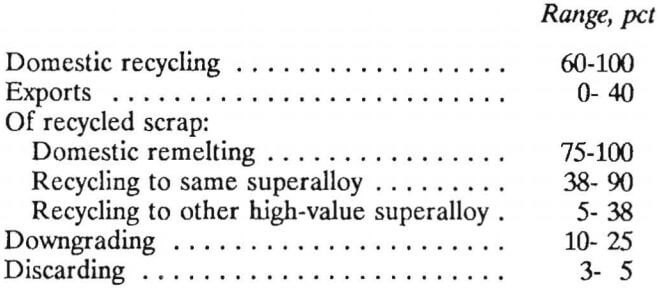
These estimates are typical of the data on processing, manufacturing, disposal, downgrading, and recycling of strategic and critical materials. Therein lies the difficulty in determining the amounts of critical and strategic commodities that are discarded, downgraded, or exported, which is the reason for conducting this study.
In 1980, the U.S. Bureau of Mines reported the results of contracted studies by Inco Research and Development Center, Suffern, NY, and Arthur D. Little, Inc., Cambridge, MA, to assess the domestic availability of chromium in scrap and the amount that was recycled. These reports contain data up to 1976 and 1978, respectively; no updates of these studies were conducted following their publication. In 1983, the National Materials Advisory Board (NMAB) published a study of the flow of cobalt in all end uses, which discussed the amounts of downgraded scrap and waste produced by the cobalt industry. The report also discussed the need for improved recycling of cobalt-containing scrap.
In May 1985, the U.S. Congress, Office of Technology Assessment (OTA) produced a study entitled “Strategic Materials: Technologies To Reduce U. S. Import Vulnerability”. Included in the study were a set of recommendations to the U.S. Bureau of Mines to conduct a survey of recycling-related activities. OTA recommended a scrap recycling study to update the chromium scrap metal information contained in two Bureau publications, as well as to expand the scope of the previous studies to include information on scrap generated by cobalt, manganese, and the platinum-group metals industries, as well as the wastes generated by all the various industrial and Department of Defense (DOD) users of these four commodities.
In 1987, the Bureau initiated this study of the four commodities. The main objective of the study is to produce a commodity-orientated structural model tracing flow, recycling, and final disposition of the four identified commodities, which can be updated in subsequent years. A second objective of the study is to provide, in an understandable manner, an overview of the commodity flow that can be used by Congress and industry associations as a tool to help in the study of that commodity’s vulnerability to political and availability factors outside the control of the United States. Another objective of the study is to highlight significant commodity loss areas where further research is required. This will enable the development of specific project proposals to address specific recycling areas.
To meet the preceding objectives of the study, a hierarchical model was developed for cobalt, and the data for cobalt are presented here. This report consists of a general description of the model and its components. This particular model is a generic model that can be applied to other strategic and critical commodities.
General Cobalt Recycling Process Description
The cobalt commodity flow model is composed of a hierarchical structure and a materials balance for each component of the hierarchy. An overview of the commodity flow model is shown in figure 1. The model structure provides a means of organizing the overall industry data and of estimating material flow and waste generation by subcomponents of the industry. The entire commodity industry is represented in the first level of the structure, with subsequent consumers in the lower levels of the structure. This hierarchical structure lends itself to a coding system for identifying the industries and their relationships. The cobalt industry, for example, splits into eight industries at the highest level: superalloys; magnetic alloys; cemented carbides; tool steels; stainless steels, heat-resistant steels, and other alloys; miscellaneous and unspecified industries; cobalt catalysts; and other chemicals. The first level of industry components would thus be coded: Co.1 for superalloys, Co.2 for magnetic alloys, Co.3 for cemented carbides, etc. Under cobalt superalloy processing would be cobalt parts manufacturing: Co.1.1. A new digit is added for each descending level in the hierarchy. For example, the end-use industries for cobalt superalloys would be Co. 1.1.1-jet engine turbine blades, Co. 1.1.2-compression rings, etc.
With adequate input data, this system permits one to simply, quickly, and unambiguously identify the subcomponents of any component of the cobalt industry. The system permits the identification of cobalt consumption or waste by industry component simply by adding all waste (or consumption) for the subcomponents. To list all the waste by the cobalt catalyst industry, for example, one simply adds the waste for all components whose labels start with “Co.7.” If one wants to know the production of scrap and waste in the cobalt superalloy parts manufacturing industry one adds the scrap from all components whose labels start with “Co.1.1.”
The data organized by the hierarchical structure include material balances by industry. This system permits “upward” and “downward” calculation of consumption and waste quantities. That is, using this structure, one can distribute domestic consumption of cobalt over the numerous industries that consume cobalt. This is “downward” calculation. One could also start by calculating consumption for the lowest components and add to get total domestic consumption. This is “upward” calculation. Using both upward and downward calculation provides a method for checking self-consistency. Using upward and downward calculation also permits the estimation of limits on data that is not otherwise attainable. For example, if 85 pct of the companies in an industry report data and the total consumption in this industry is known, then the estimates of the contributions of the other 15 pct of the companies can be calculated by difference.
Minimally, for the purpose of identifying scrap and waste generation sources, recycling routes, and potential recycling opportunities, each component should have a quantified cobalt input and output, in contained weight and in gross weight by material. The difference between input and output is identified waste. One can balance input and output in contained cobalt units to determine whether unidentified waste streams are significant
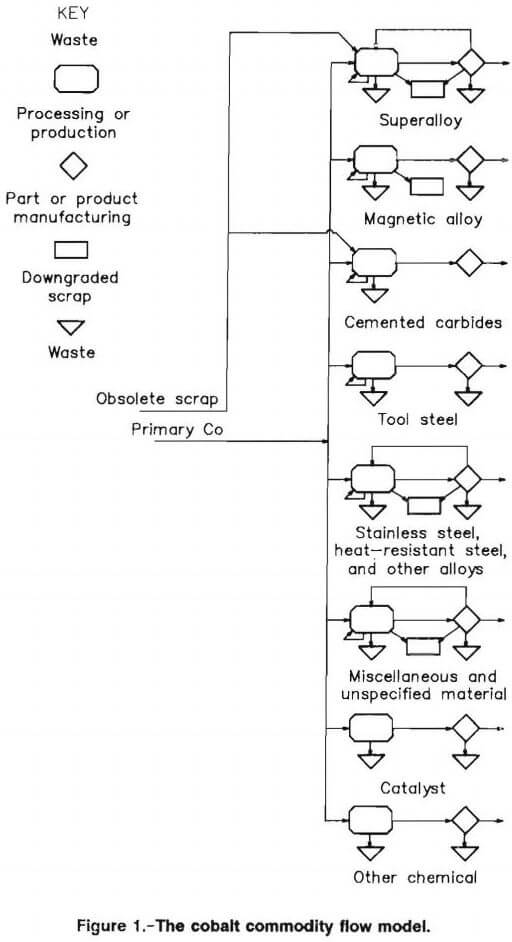
Each industry material balance is the result of material balances for individual processes. For example, in the production of superalloys, a detailed materials balance should be produced for each superalloy production operation. It is likely that each company has a different furnace, uses a different melting procedure, produces to different chemical specifications, recycles differently, and has different economic restrictions. All of these factors affect the fraction of input materials that reports to output product, recyclable material, or waste. It is at this level that information on recycling potential is most valuable. It is at this level that individual waste streams and scrap that leave the production process are identified and characterized (quantity, concentration, contamination, etc.), and that unidentified waste is quantified.
With the hierarchical structure of the industry, the input-output materials balance for each component, and the detailed materials balance for each process that makes up an industry component, a “blueprint” for commodity data collection and organization has been developed. The base of this system is the process material balance. The process material balances are then aggregated to form the Industry material balance. The industry components are organized by the hierarchical structure, which identifies material flows among industry components.
The model developed here for the study of scrap and waste generated by cobalt processing and consuming industries is a blueprint or guideline for organizing a logical study of cobalt flow. The waste and scrap generated through the use of cobalt materials is identified through application of the material balance concept. This model divides the cobalt industry into smaller parts, which should make data collection and analysis as well as data revision more manageable. Problems may arise in application of this model; for example, some companies may be reluctant to provide data. But the model is general and flexible enough to be adapted to these problems.
Cobalt Industry Flow Models
Neither the reported consumption nor the apparent consumption of cobalt in any given year necessarily equals the actual consumption of cobalt in that year. “Reported consumption” is those data reported to the U.S. Bureau of Mines in response to the Bureau’s industry consumption survey questionnaires. The “apparent consumption” equals primary production plus production from old scrap plus (imports minus exports) plus (beginning inventories minus ending inventories). Apparent consumption is closer to actual consumption, but reported consumption provides a breakdown by end use
In developing the overall cobalt flow models, the following guidelines were used:
- The difference between reported consumption and apparent consumption was prorated among the various level 2 industry components, because there are insufficient data to determine where the difference belongs;
- It was assumed that the amount of cobalt in each of the level 2 industry flows that reported to loss, downgrade, prompt scrap, flow to manufacturing, and flow to final product was proportional to the 1980 data reported by NMAB and that this proportionment is still valid at this time;
- The portions of loss and downgraded material for most of the metals that appear as solid scrap, mixed scrap, turnings, grindings, and waste were assumed to be proportioned as reported by Curwick, Petersen, and Makar.
The cobalt industry consumption data for 1987 are shown in table 1.
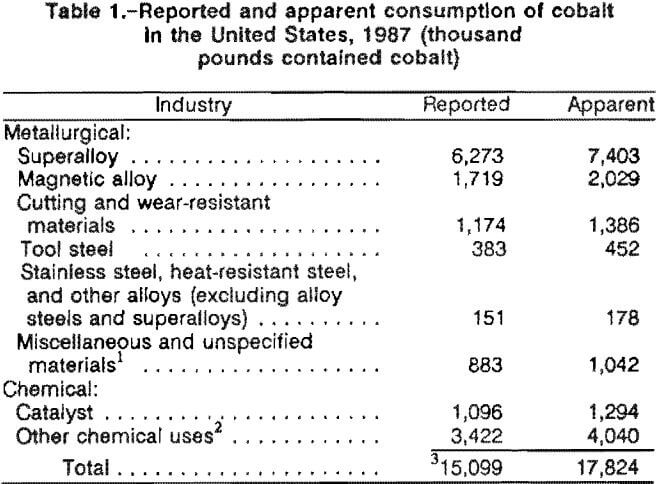
Cobalt Superalloys
The flow of cobalt in the superalloy industry is shown in figure 2. Quantities were generated by the model, using the following assumptions:
- The reported amount of cobalt contained in recycled obsolete scrap (13) is proportioned only to superalloy and cemented carbides processing.
- The amount of cobalt from obsolete scrap used in cemented carbides is proportional to the ratio of obsolete scrap cobalt input to cemented carbides to total cobalt input to cemented carbides shown by NMAB (500 units of cobalt in obsolete scrap per 1,344 units of total cobalt input).
- The input of cobalt in obsolete scrap to superalloy production is the difference between contained cobalt in total consumed obsolete scrap and contained cobalt in ob-solete scrap consumed in production of cemented carbides.
- The difference between total apparent consumption of cobalt in superalloy production and that part from obsolete scrap is primary cobalt.
- The ratio of primary cobalt consumed in wrought products to that consumed in cast products is 2.0.
The composite flow of superalloys in the manufacture of parts is the sum of two independent flows, which are the production of wrought alloy parts and cast parts (fig. 2).
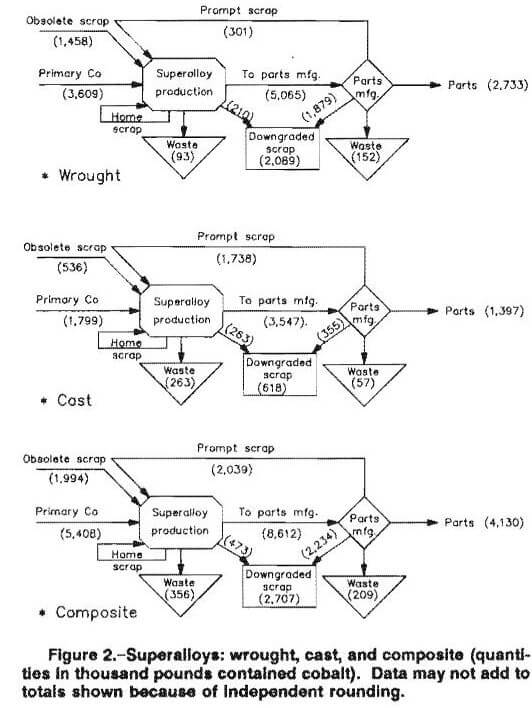
In the superalloy industry there are two types of processing: In the first, metal is processed to an alloy and this material, in the form of a billet or ingot, then goes to producing a manufactured part (wrought). In the second, the alloy is prepared by the melting of pure metals by the parts manufacturer immediately prior to casting the parts (cast). To simplify the model, these two different operations are summed up as a composite flow sequence of superalloy processing and parts manufacturing.
From the model, the following figures were generated. In 1987, the superalloy industry consumed materials estimated to contain 7,403,000 lb of cobalt, generated waste material estimated to contain 565,000 lb of cobalt, and downgraded material estimated to contain 2,707,000 lb of cobalt. The distribution of this material is shown in table 2. In many cases the loss to downgrade is due to the fact that specifications for certain end-use products require the use of virgin metal to produce the alloys. These requirements cause large amounts of scrap material to be used as a cobalt source for alloys with lower concentrations of cobalt and lower economic values (downgraded.)
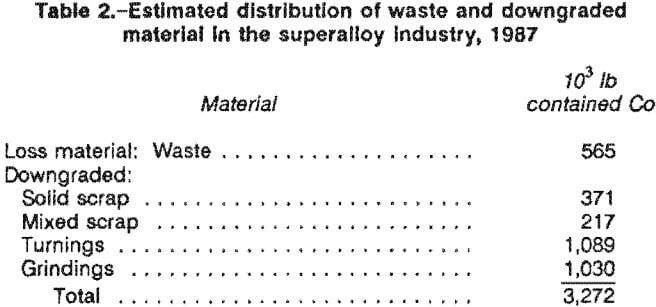
Cobalt Magnetic Alloys
The manufacture of magnets involves two major processes, wrought alloy processing and casting. The flows of cobalt in the manufacture of magnets with wrought and cast alloys are shown in figure 3. The composite flows of cobalt in all magnet manufacturing are also shown in figure 3. The flows were estimated based on the data of Curwick, Petersen, and Makar and NMAB. An estimated 2,029,000 lb of cobalt was used in magnet manufacture in 1987. Of this amount, an estimated 141,000 lb of cobalt reported to waste, 79,000 lb of cobalt to downgrade, and 1,808,000 lb of cobalt to magnets. The distribution of waste and downgraded materials is shown in table 3. NMAB states that essentially no obsolete cobalt magnet scrap was recycled to the production of cobalt-containing products.
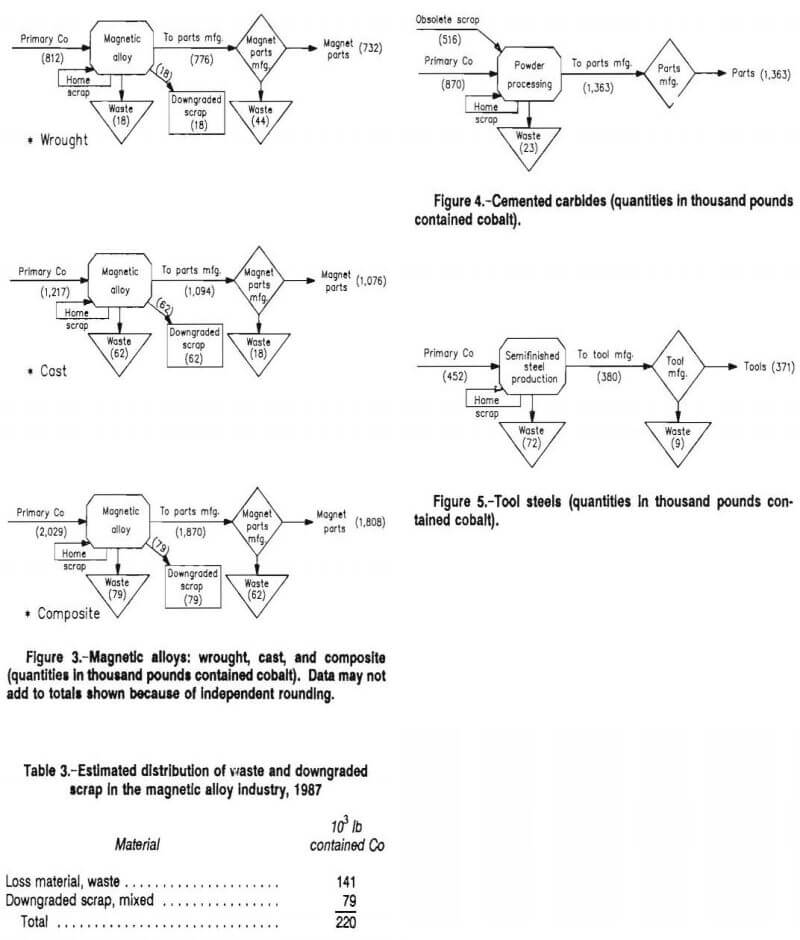
Tool Steels
The primary use for this product is in high-speed tools. Cobalt is added to tungsten-chromium hot-work tool steels to increase the toughness and strength of the alloy at high temperatures. The flows of cobalt in this industry are based on NMAB data and are shown in figure 5. In this industry an estimated 452,000 lb of cobalt is used to produce high-speed tools containing an estimated 371,000 lb of cobalt. The production and manufacturing losses of waste are estimated to contain 81,000 lb of cobalt.
Stainless Steels Heat-Resistant Steels
and Other Alloys (Excluding Alloy Steels and Superalloys)
The primary end use of products of this industry is in applications where heat and corrosion resistance are required. The flows of cobalt in this industry are shown in figure 6. A total of 208,000 lb of contained cobalt was estimated to go into production of the final products. Of this, 178,000 lb was primary cobalt and the remainder was prompt scrap containing 30,000 lb of cobalt. During production operations, an estimated 12,000 lb of contained cobalt reported as waste and 39,000 lb of contained cobalt reported as downgraded scrap. Using the data of Curwick, Petersen, and Makar, the downgraded material is estimated to break down into solid scrap, mixed scrap, and grindings as shown in table 4. The final products were estimated to contain 128,000 lb of cobalt. NMAB reports that essentially no obsolete cobalt-containing scrap is used by this industry.
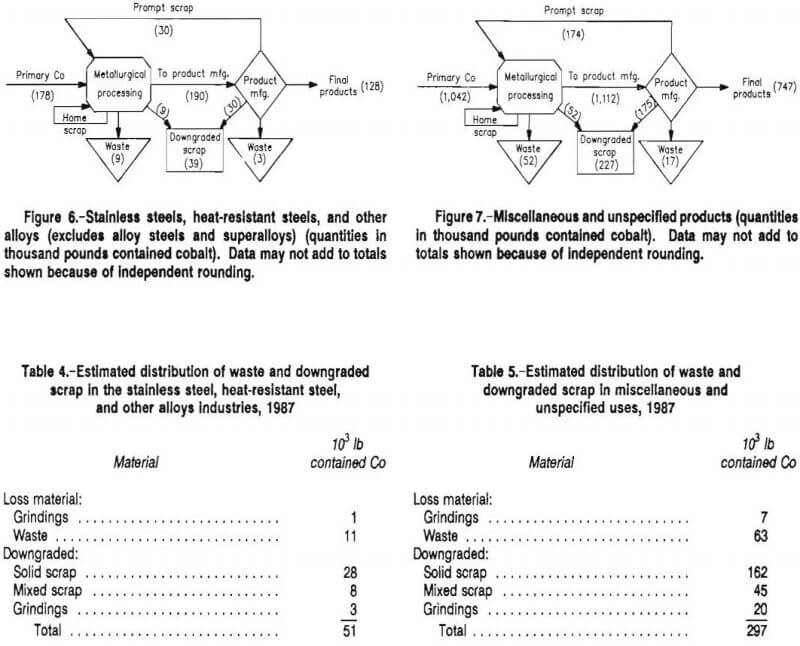
Miscellaneous and Unspecified Uses
This series of end use industries produces the following products: welding materials for structural and hard facing applications, high-strength low-alloy steels, full alloy steels, nonferrous alloys, mill products made from metal powder, and other unspecified uses. Individual data are withheld by the Bureau to avoid disclosing company proprietary data. Information in the 1979 to 1984 Minerals Yearbooks indicates that an average of 82 pct of the currently designated miscellaneous and unspecified materials were known to be metal alloys. Thus, a metallurgical flow model used by NMAB was used as a blueprint for this portion of the cobalt industry. The data are shown in figure 7. NMAB states that essentially no obsolete cobalt-containing scrap is used to produce these products. An estimated 1,042,000 lb of primary cobalt was used by these industries in 1987. From this input, the processing and manufacturing parts of the industries were estimated to produce final products containing 747,000 lb of cobalt. During the processing and manufacturing operations, waste material containing 69,000 lb of cobalt and downgraded scrap containing 227,000 lb of cobalt were generated. Estimates, based on the data of Curwick, Petersen, and Makar, show that the downgraded scrap can be broken down into solids, mixed scrap, and grindings as shown in table 5.
Catalysts
A major use of cobalt in chemical products is as catalysts. The catalysts are used for hydrogenation, hydration, desulfurization, oxidation, reduction, and synthesis of hydrocarbons. The flows of cobalt in the catalyst industry are shown in figure 8. The amounts in the flowchart are estimated using data from NMAB. In 1987, an input of materials containing an estimated 1,294,000 lb of cobalt produced catalysts containing an estimated 1,218,000 lb of cobalt. Process and manufacturing waste materials contained an estimated 76,000 lb of cobalt. Some of these catalysts can be regenerated several times, but ultimately the fate of most is disposal or metal recovery. The Bureau has developed technology to recover cobalt from the spent catalysts, and there is currently some reported use of recycling technology by industry. Deering reports that between 500,000 and 1,000,000 lb of cobalt is recovered from spent catalysts annually. This recycling activity would lead to an estimated disposal of spent catalysts containing in the range of 218,000 to 718,000 lb of cobalt per year.
Other Chemicals
This industry produces chemicals in the form of paint driers for lacquers, enamels and varnishes; feed additives;
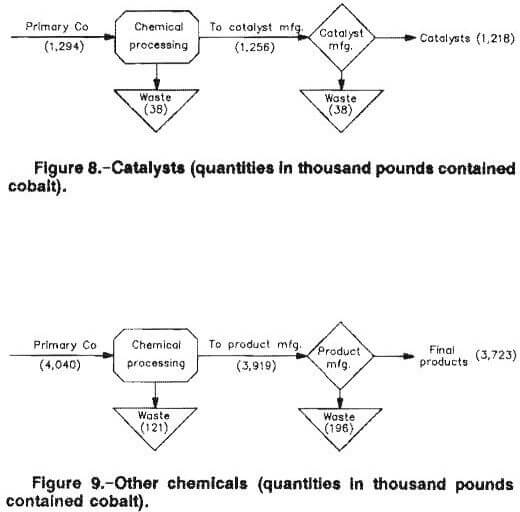
decolorizers for soda-lime-silicate glasses; ground glass frits to improve the adherence of porcelain enamels to sheet metal; pigments in colors of violet, blue, green, and pink; and salts. The flows of cobalt in this industry are shown in figure 9. Chemical processing efficiency is about 97 pct, and chemical manufacturing efficiency is somewhat lower, about 95 pct. These values were used in defining flows within this industry. The model estimates that the industry used about 4,040,000 lb of primary cobalt in 1987. This reports as waste material containing 317,000 lb of cobalt and final products containing 3,723,000 lb of cobalt. The model’s estimated distribution of cobalt among these products based on reported consumption is shown in table 6. About two-thirds of the products are paint driers.
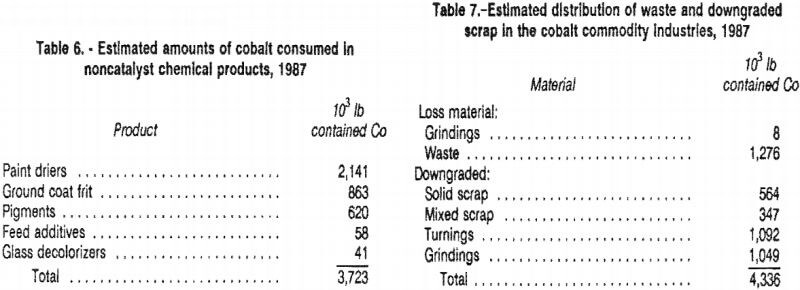
Cobalt Material Flows
The overall flows of cobalt in the industries using cobalt are shown in figure 10. In the chemical portion of the flowchart, in 1987, the industries consumed an estimated 5,334,000 lb of cobalt. During processing and manufacturing operations, materials containing an estimated 393,000 lb of cobalt were lost as waste. The final products contain an estimated 4,941,000 lb of cobalt. Approximately two-thirds of this material is used in dissipative end uses where recovery and recycling do not occur. Some metal recovery from catalysts has been reported by Deering. In the metallurgical portion of the flowchart, in 1987, the industries consumed obsolete scrap containing an estimated 2,510,000 lb of cobalt, an estimated 9,980,000 lb of primary cobalt, and prompt scrap containing an estimated 2,243,000 lb of cobalt. During processing and manufacturing, materials containing an estimated 893,000 lb of cobalt were lost as waste, and scrap materials containing an estimated 3,052,000 lb of cobalt were downgraded with significant loss of cobalt values. The final products contain an estimated 8,547,000 lb of cobalt. Based on prior studies of the content of waste and downgraded scrap streams, the waste and downgraded scrap streams are divided as shown in table 7. These losses and downgrades caused the resource loss of about 24 pct of the 1987 apparent consumption of cobalt; the downgraded scrap is either melted to other alloys in which the cobalt may be lost or greatly diluted, or exported for refining to recover nickel and cobalt. There is much uncertainty about the portion of the downgraded and obsolete scrap that goes to export. The U.S. Bureau of Mines reported that 403,000 lb of contained cobalt was exported in 1987. This includes cast cobalt materials, cobalt alloys, waste, and scrap. Estimates from Bureau of Census data for 1987 reported by the U.S. Bureau of Mines indicate the contained cobalt exported to be about 806,000 lb. There do not appear to be valid figures for the amounts from wastes and scrap in these estimates.
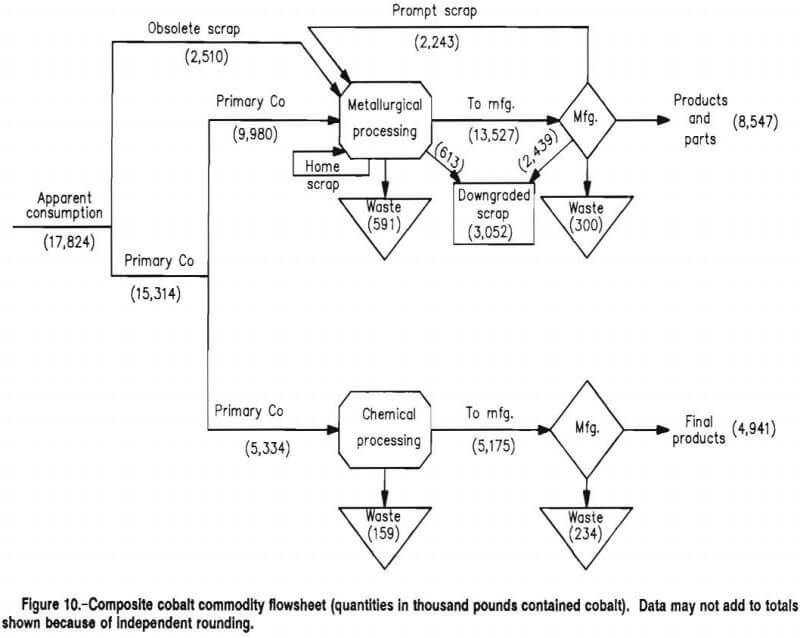
Summary
A Bureau commodity flow model was updated and computerized for the industries that consume cobalt. Based on available data, the flow model follows cobalt through its processing and manufacturing industries showing estimated values for material lost through disposal, downgrading, and dissipation. The model was prepared using certain estimates and assumptions. The model has the capability of easy updating as new data become available.
An industry flowchart was presented for each of the industries that consume cobalt. The flow of the entire cobalt commodity was also described based on the flows in the individual industries (fig. 10). The apparent consumption of cobalt in 1987 was 17,824,000 lb. The estimated amounts consumed by the various industries were shown in table 1. The largest consumer was the superalloy industry, which used material containing 7,403,000 lb of cobalt in its operations. This was estimated to be composed of obsolete scrap containing 1,994,000 lb of cobalt and 5,409,000 lb of primary cobalt. This industry was also the largest producer of downgraded scrap and wastes, producing downgraded scrap containing 2,707,000 lb of cobalt and waste containing 565,000 lb of cobalt (table 8). Other high losses of cobalt occurred in the chemical industries and in the miscellaneous and unspecified areas. Over all, downgraded scrap material containing an estimated 3,052,000 lb of cobalt and waste material containing an estimated 1,284,000 lb of cobalt were produced. In addition to these amounts, an estimated 3,290,000 lb of cobalt is consumed in dissipative chemical and catalyst end uses.
Based on the estimated lifetimes of various metal products (1) and the estimated amounts of products produced in 1977 (10 years), 1982 (5 years), and 1985 (2 years), in 1987 there should have been potentially recyclable metal products containing 8,432,000 lb of cobalt. Table 9 shows the distribution of these products, their potential life span, the amount of cobalt content potentially recyclable, and the amount estimated to have been recycled to the same alloy without downgrading. About 83 pct of obsolete superalloy scrap and 52 pct of the obsolete cemented carbide scrap is estimated to be recycled. Overall, only an estimated 30 pct of the total obsolete scrap was efficiently recycled. Assumptions are that essentially no obsolete scrap is effectively recycled from magnets, tool steels, stainless and heat-resistant steels, and miscellaneous and unspecified material. Thus, there is an estimated 5,922,000 lb of contained cobalt in the obsolete scrap that is not recycled to the same or equal-value alloy.
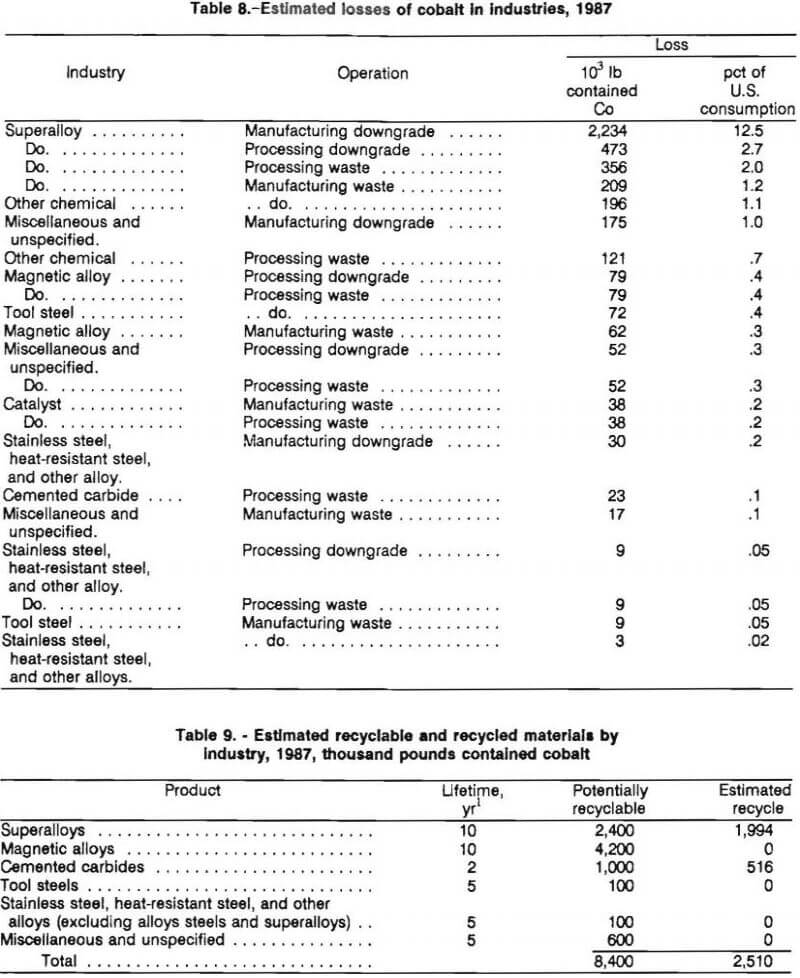
Conclusions
A cobalt commodity flow model has been developed. The model is set up in a hierarchical manner with levels for the various industries and subindustries. The mathematical relationships in the model are discussed in the appendix. The model shows the distribution of apparent 1987 consumption of 17,824,000 lb of cobalt in eight subindustries. Estimates in table 8 show production of downgraded scrap containing 3,052,000 lb cobalt and loss or waste material containing 1,284,000 lb cobalt. The largest producer of scrap and waste is the superalloy industry, in which scrap and waste produced during alloy processing and parts manufacturing contain 5,311,000 lb of cobalt. Of this, 2,039,000 lb of contained cobalt was in prompt scrap that was reused by the industry. The remaining material containing 3,271,000 lb cobalt is divided into downgraded scrap with 2,707,000 lb of cobalt and waste with 565,000 lb of cobalt. These two loss areas are places where prime concern should be addressed in studies of recycling. The principal cause of the downgrading of materials is that certain end uses require virgin metal, and thus, any scrap is downgraded to production of lower value alloys or alloys where the cobalt is lost in processing.
The development of this flow model has highlighted areas where data are needed to make the model more effective. There are few or no current data available on the amounts of material that report as solid scrap, mixed scrap, turnings, grindings, and waste. The amounts calculated in this model are based on data from 1980 and 1976. In the past outside contractors have gathered these data. The Bureau needs to make changes in its data gathering survey sheets to obtain the required information on a continuing basis so that this model can be kept up to date. There are some Environmental Protection Agency data that are useful in determining the amounts of waste and downgraded material, but even these data have substantial gaps.
